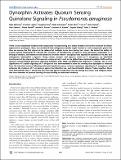| dc.contributor.author | Zaborina, Olga | |
| dc.contributor.author | Lepine, Francois | |
| dc.contributor.author | Xiao, Gaoping | |
| dc.contributor.author | Valuckaite, Vesta | |
| dc.contributor.author | Chen, Yimei | |
| dc.contributor.author | Li, Terry | |
| dc.contributor.author | Ciancio, Mae | |
| dc.contributor.author | Zaborin, Alex | |
| dc.contributor.author | Petroff, Elaine | |
| dc.contributor.author | Turner, Jerrold R | |
| dc.contributor.author | Chang, Eugene | |
| dc.contributor.author | Alverdy, John C | |
| dc.contributor.author | Rahme, Laurence G. | |
| dc.date.accessioned | 2011-04-27T03:11:54Z | |
| dc.date.issued | 2007 | |
| dc.identifier.citation | Zaborina, Olga, Francois Lepine, Gaoping Xiao, Vesta Valuckaite, Yimei Chen, Terry Li, Mae Ciancio, et al. 2007. Dynorphin activates quorum sensing quinolone signaling in Pseudomonas aeruginosa. PLoS Pathogens 3(3): e35. | en_US |
| dc.identifier.issn | 1553-7366 | en_US |
| dc.identifier.uri | http://nrs.harvard.edu/urn-3:HUL.InstRepos:4878076 | |
| dc.description.abstract | There is now substantial evidence that compounds released during host stress directly activate the virulence of certain opportunistic pathogens. Here, we considered that endogenous opioids might function as such compounds, given that they are among the first signals to be released at multiple tissue sites during host stress. We tested the ability of various opioid compounds to enhance the virulence of Pseudomonas aeruginosa using pyocyanin production as a biological readout, and demonstrated enhanced virulence when P. aeruginosa was exposed to synthetic (U-50,488) and endogenous (dynorphin) κ-agonists. Using various mutants and reporter strains of P. aeruginosa, we identified involvement of key elements of the quorum sensing circuitry such as the global transcriptional regulator MvfR and the quorum sensing-related quinolone signaling molecules PQS, HHQ, and HQNO that respond to κ-opioids. The in vivo significance of κ-opioid signaling of P. aeruginosa was demonstrated in mice by showing that dynorphin is released from the intestinal mucosa following ischemia/reperfusion injury, activates quinolone signaling in P. aeruginosa, and enhances the virulence of P. aeruginosa against Lactobacillus spp. and Caenorhabditis elegans. Taken together, these data demonstrate that P. aeruginosa can intercept opioid compounds released during host stress and integrate them into core elements of quorum sensing circuitry leading to enhanced virulence. | en_US |
| dc.language.iso | en_US | en_US |
| dc.publisher | Public Library of Science | en_US |
| dc.relation.isversionof | doi:10.1371/journal.ppat.0030035 | en_US |
| dc.relation.hasversion | http://www.ncbi.nlm.nih.gov/pmc/articles/PMC1828698/pdf/ | en_US |
| dash.license | LAA | |
| dc.subject | gastroenterology and hepatology | en_US |
| dc.subject | infectious diseases | en_US |
| dc.subject | microbiology | en_US |
| dc.subject | pathology | en_US |
| dc.subject | eubacteria | en_US |
| dc.subject | Mus (mouse) | en_US |
| dc.subject | caenorhabditis | en_US |
| dc.title | Dynorphin Activates Quorum Sensing Quinolone Signaling in Pseudomonas aeruginosa | en_US |
| dc.type | Journal Article | en_US |
| dc.description.version | Version of Record | en_US |
| dc.relation.journal | PLoS Pathogens | en_US |
| dash.depositing.author | Rahme, Laurence G. | |
| dc.date.available | 2011-04-27T03:11:54Z | |
| dash.affiliation.other | HMS^Surgery-Massachusetts General Hospital | en_US |
| dc.identifier.doi | 10.1371/journal.ppat.0030035 | * |
| dash.authorsordered | false | |
| dash.contributor.affiliated | Rahme, Laurence | |


